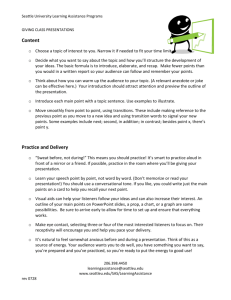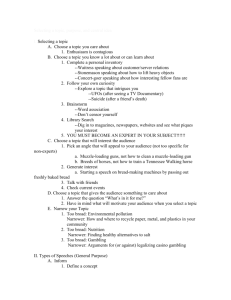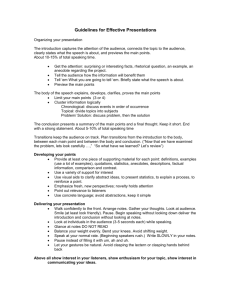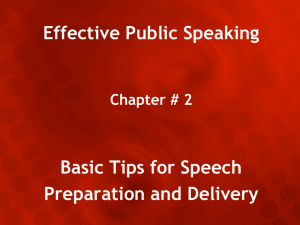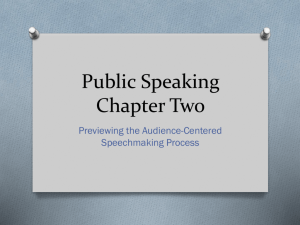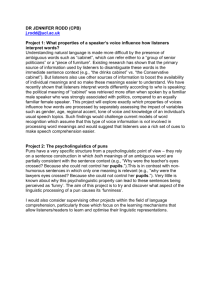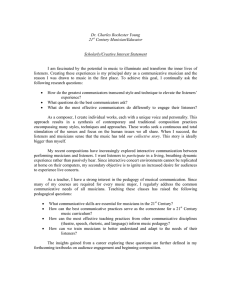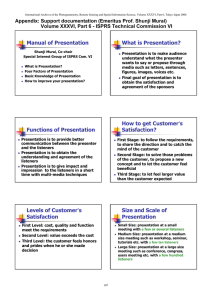QUICK GUIDE TO PUBLIC SPEAKING This simplified guide is
advertisement
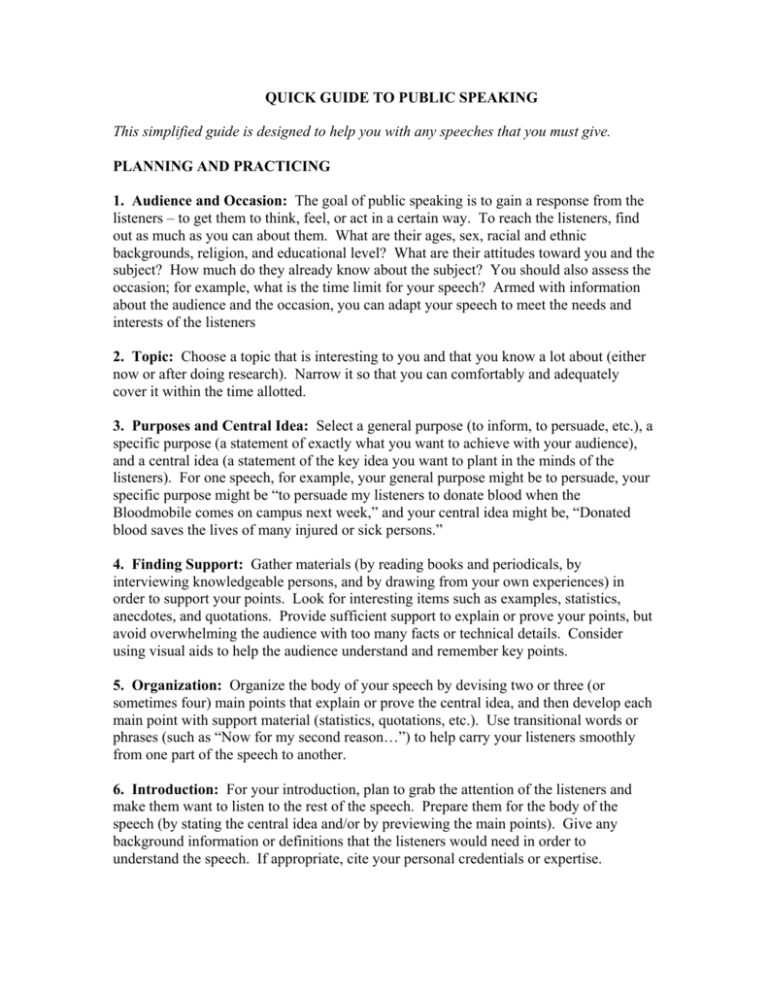
QUICK GUIDE TO PUBLIC SPEAKING This simplified guide is designed to help you with any speeches that you must give. PLANNING AND PRACTICING 1. Audience and Occasion: The goal of public speaking is to gain a response from the listeners – to get them to think, feel, or act in a certain way. To reach the listeners, find out as much as you can about them. What are their ages, sex, racial and ethnic backgrounds, religion, and educational level? What are their attitudes toward you and the subject? How much do they already know about the subject? You should also assess the occasion; for example, what is the time limit for your speech? Armed with information about the audience and the occasion, you can adapt your speech to meet the needs and interests of the listeners 2. Topic: Choose a topic that is interesting to you and that you know a lot about (either now or after doing research). Narrow it so that you can comfortably and adequately cover it within the time allotted. 3. Purposes and Central Idea: Select a general purpose (to inform, to persuade, etc.), a specific purpose (a statement of exactly what you want to achieve with your audience), and a central idea (a statement of the key idea you want to plant in the minds of the listeners). For one speech, for example, your general purpose might be to persuade, your specific purpose might be “to persuade my listeners to donate blood when the Bloodmobile comes on campus next week,” and your central idea might be, “Donated blood saves the lives of many injured or sick persons.” 4. Finding Support: Gather materials (by reading books and periodicals, by interviewing knowledgeable persons, and by drawing from your own experiences) in order to support your points. Look for interesting items such as examples, statistics, anecdotes, and quotations. Provide sufficient support to explain or prove your points, but avoid overwhelming the audience with too many facts or technical details. Consider using visual aids to help the audience understand and remember key points. 5. Organization: Organize the body of your speech by devising two or three (or sometimes four) main points that explain or prove the central idea, and then develop each main point with support material (statistics, quotations, etc.). Use transitional words or phrases (such as “Now for my second reason…”) to help carry your listeners smoothly from one part of the speech to another. 6. Introduction: For your introduction, plan to grab the attention of the listeners and make them want to listen to the rest of the speech. Prepare them for the body of the speech (by stating the central idea and/or by previewing the main points). Give any background information or definitions that the listeners would need in order to understand the speech. If appropriate, cite your personal credentials or expertise. 7. Conclusion: Plan to end with a conclusion that smoothly wraps up your speech and reinforces the central idea. 8. Outline: Put together all parts of the speech (introduction, body, conclusion, and transitions) in an outline. Make sure that everything in the outline serves to explain, illustrate, or prove the central idea. Prepare brief speaking notes based on the outline; these notes should be the only cues you take with you to speak. 9. Practice: Rehearse your speech several times in front of a live audience of friends or relatives. Do not memorize your speech, but strive to rehearse ideas (as cued by your brief speaking notes). DELIVERING THE SPEECH 1. Self-Confidence: Try to develop a positive attitude about yourself, your speech, and your audience. Don’t let fear cripple you: nervousness is a normal and natural part of speechmaking for most people; rather than trying to banish your jitters, you should use nervousness as a source of power that will energize you, causing you to come across as a vital, enthusiastic speaker. 2. Approach & Beginning: When you are called to speak, get out of your seat without sighing or mumbling, walk confidently to the front of the room, spend a few moments standing in silence (this is a good time to arrange your notes and get your first sentences firmly in mind), and then look directly at the audience as you begin your speech. 3. Eye Contact: Look at all parts of the audience throughout the speech, glancing down at your notes only occasionally. Avoid looking out a window or at the walls, ceiling, or floor. 4. Speaking Rate: Speak at a rate that is easy for the audience to absorb. Avoid speaking too slow or too fast. When appropriate, use pauses. 5. Expressiveness: Your voice should sound as animated and as expressive as it does when you carry on a conversation with a friend. 6. Clarity & Volume: Pronounce your words distinctly and speak loud enough so that everyone in the audience can clearly hear you. Avoid verbal fillers such as uh, ah, er, okay, ya know. 7. Gestures & Movement: If it’s appropriate, use gestures to accompany your words. Make them naturally and gracefully, so that they add to, rather than distract from, your message. If movement is appropriate, use it purposefully. Refrain from distracting the audience with aimless movements or activities (such as pacing about, jingling keys or coins, or fidgeting with note cards). 8. Posture & Poise: You should look comfortable, yet poised and alert, as you stand before the audience. Avoid leaning on anything or slouching. 9. Use of Notes: Your notes should be inconspicuous and used only for occasional reference. Don’t read them or absentmindedly stare at them. 10. Enthusiasm: Your whole manner – eyes, facial expression, posture, voice – should show enthusiasm for your subject, and you should seem genuinely interested in communicating your ideas to the audience, rather than simply going through the motions of “giving a speech.” 11. Ending & Departure: You should say your conclusion and then pause a few moments. Don’t give the appearance of being anxious to get back to your seat (by pocketing your notes or by taking a step toward your seat).

